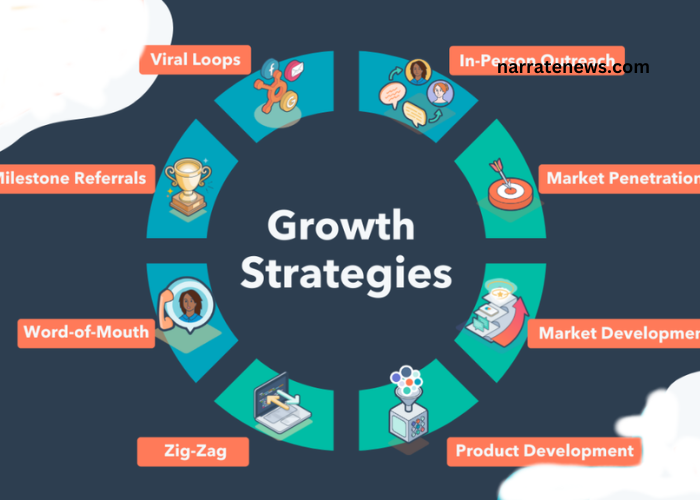
The Role of a Business Growth Strategist
In the ever-evolving landscape of business, the need for strategic vision and growth has never been more critical. As companies strive to navigate complex markets, competition, and technological advancements, the role of a Business Growth Strategist has emerged as a guiding force. In this in-depth exploration, we will delve into the multifaceted world of business growth strategy, examining the responsibilities, skills, and impact of a Business Growth Strategist in shaping the success and sustainability of organizations.
Defining the Business Growth Strategist:
A Business Growth Strategist is a seasoned professional with a profound understanding of business dynamics, market trends, and organizational structures. Unlike a traditional business consultant, a Growth Strategist focuses on formulating and implementing strategies that drive sustainable expansion and long-term success.
The Evolving Landscape of Business Growth:
In an era marked by rapid technological advancements and global interconnectedness, businesses face both unprecedented opportunities and challenges. A skilled Business Growth Strategist is attuned to these dynamics, leveraging market trends, consumer behavior, and emerging technologies to chart a course for growth.
Core Responsibilities of a Business Growth Strategist:
a. Comprehensive Analysis:
A Growth Strategist begins by conducting a thorough analysis of the business environment. This includes assessing market conditions, industry trends, and competitors to identify growth opportunities and potential threats.
b. SWOT Analysis:
Employing a SWOT analysis (Strengths, Weaknesses, Opportunities, Threats), a Growth Strategist evaluates the internal and external factors influencing the organization. This strategic assessment forms the basis for future planning.
c. Goal Setting:
Clear and measurable goals are crucial for any growth strategy. The Business Growth Strategist collaborates with key stakeholders to define realistic yet ambitious objectives that align with the organization’s mission and vision.
d. Market Positioning:
Crafting a compelling value proposition and defining the organization’s unique selling points are key aspects of market positioning. A Growth Strategist works to differentiate the business from competitors and enhance its appeal to target audiences.
e. Diversification and Innovation:
To foster sustained growth, a Business Growth Strategist explores avenues for diversification and innovation. This involves identifying new product or service offerings, exploring untapped markets, and embracing emerging technologies.
f. Risk Management:
Acknowledging and mitigating risks is integral to any growth strategy. The strategist assesses potential challenges and develops contingency plans to ensure the organization can adapt to unforeseen circumstances.
g. Collaboration and Communication:
Effective communication and collaboration are paramount. A Growth Strategist works closely with various departments within the organization, fostering a culture of collaboration to ensure that growth initiatives align with the overall business strategy.
h. Monitoring and Evaluation:
Implementing a growth strategy is an ongoing process. A Business Growth Strategist monitors key performance indicators (KPIs) and regularly evaluates the success of growth initiatives. This iterative approach allows for adjustments and refinements as needed.
Skills and Attributes of a Successful Business Growth Strategist:
a. Analytical Acumen:
The ability to analyze data, interpret market trends, and derive actionable insights is a foundational skill for a Growth Strategist. This analytical acumen informs strategic decision-making.
b. Strategic Vision:
A Growth Strategist possesses a forward-thinking perspective, envisioning the future landscape of the business and industry. This visionary mindset guides the development of long-term growth plans.
c. Adaptability:
In the dynamic business environment, adaptability is crucial. A Growth Strategist navigates change with resilience, adjusting strategies in response to shifting market conditions and organizational needs.
d. Communication Skills:
Effective communication is at the heart of successful growth initiatives. A Growth Strategist communicates complex strategies in a clear and compelling manner, ensuring alignment across the organization.
e. Leadership Abilities:
Leadership qualities are essential for influencing and inspiring teams. A Growth Strategist motivates cross-functional teams, fostering a shared commitment to the organization’s growth objectives.
f. Negotiation Skills:
Collaborating with stakeholders, negotiating partnerships, and securing resources are common aspects of growth strategy implementation. A skilled negotiator can leverage opportunities for the organization’s benefit.
g. Technological Fluency:
Embracing technology is integral to modern growth strategies. A Growth Strategist stays abreast of technological advancements, leveraging tools and platforms to enhance organizational efficiency and effectiveness.
h. Financial Literacy:
Understanding financial principles and managing budgets is a critical aspect of growth planning. A Growth Strategist ensures that growth initiatives are financially viable and contribute to the overall fiscal health of the organization.
Case Studies in Business Growth Strategy:
To illustrate the tangible impact of a Business Growth Strategist, exploring real-world case studies provides valuable insights:
a. Amazon:
Amazon’s relentless focus on customer-centric strategies and continuous diversification into new markets exemplifies effective growth strategy. The company’s expansion from an online bookstore to a global e-commerce giant and cloud computing powerhouse reflects strategic vision and adaptability.
b. Apple:
Apple’s success is intricately tied to its innovative product launches and ecosystem integration. By consistently introducing groundbreaking devices and services, Apple has maintained a strong market position and customer loyalty.
c. Tesla:
Tesla’s disruptive entry into the automotive industry, coupled with its commitment to sustainable technology, showcases the impact of a growth strategy centered on innovation. The company’s success in the electric vehicle market is a testament to strategic vision and market positioning.
d. Netflix:
Netflix revolutionized the entertainment industry by transitioning from a DVD rental service to a global streaming platform. Through strategic content creation, international expansion, and technological innovation, Netflix has become a dominant force in the media landscape.
The Collaborative Role of Business Growth Strategists and Marketing:
Business Growth Strategists work in tandem with marketing professionals to amplify the impact of growth initiatives. A cohesive strategy integrates marketing efforts to enhance brand visibility, attract customers, and drive revenue. Marketing campaigns aligned with growth objectives contribute to the overall success of the organization’s expansion plans.
Challenges and Considerations in Business Growth Strategy:
a. Risk Management:
Growth initiatives inherently involve risk. A Growth Strategist must be adept at identifying, assessing, and mitigating risks to safeguard the organization’s stability.
b. Cultural Alignment:
Implementing growth strategies requires alignment with the organization’s culture. A Growth Strategist navigates the complexities of cultural dynamics to ensure a cohesive and united approach to growth.
c. Resource Allocation:
Efficient allocation of resources is a common challenge. A Growth Strategist must prioritize initiatives, balancing short-term gains with long-term sustainability.
d. Competitive Landscape:
The business landscape is fiercely competitive. A Growth Strategist monitors competitors, identifies differentiators, and positions the organization strategically to gain a competitive edge.
e. Economic Factors:
External economic factors can impact growth plans. A Growth Strategist remains vigilant to economic trends, adapting strategies to thrive in varying economic conditions.
f. Regulatory Compliance:
Navigating regulatory requirements is vital. A Growth Strategist ensures that growth initiatives comply with relevant laws and regulations, mitigating legal risks.
Measuring Success: Key Performance Indicators (KPIs) in Business Growth:
The effectiveness of a growth strategy is measured through a set of Key Performance Indicators (KPIs). These metrics vary depending on organizational goals but often include revenue growth, customer acquisition rates, market share expansion, and return on investment. Regularly assessing KPIs allows a Growth Strategist to gauge the success of implemented strategies and make data-driven adjustments.
The Future of Business Growth Strategy:
As technology continues to advance and global markets evolve, the role of a Business Growth Strategist remains pivotal. The future of growth strategy will likely involve increased reliance on data analytics, artificial intelligence, and sustainable business practices. Embracing innovation, staying agile, and fostering a culture of continuous improvement will be key components of successful growth strategies in the years to come.
Conclusion:
A Business Growth Strategist serves as a catalyst for organizational evolution, driving initiatives that propel businesses toward success and sustainability. By combining analytical prowess, strategic vision, and effective collaboration, these professionals navigate the complexities of the business landscape, turning challenges into opportunities. As organizations strive for growth in an ever-changing world, the strategic guidance provided by a skilled Growth Strategist becomes not only a valuable asset but a cornerstone for enduring success. In unleashing the potential for growth, these professionals contribute to the resilience, adaptability, and innovation that define the businesses of tomorrow.


